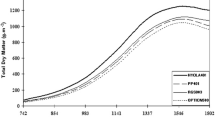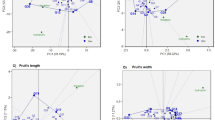Abstract
Stability of foliage yield and its quality components has not been investigated in vegetable chenopods due to their underutilized status. The objectives of the present study were to assess genotype-environment interactions (GEI), determine stability of yield and quality components and to compare different parametric and non-parametric stability parameters. The present study reports for the first time the effect of genotype and environment on foliage yield and three leaf quality traits viz. carotenoid, ascorbic acid and protein content in different species of Chenopodium. Twenty accessions comprising four species were tested in a randomized block design with three replications across four environments. For all the four traits the largest sum of squares was accounted for by the genotypes, followed by GEI and environments. Highest foliage yield of 16.02 q/ha was obtained from C. album PRC 9804, while the lowest was from C. album CHEN 63/80 (4.01 q/ha). Many indigenous accessions of C. album (PRC 9801, IC 107299, ‘Chandigarh’, ‘local’ and ‘NEFA’) were unstable both for foliage yield and most of the quality traits. Most of the exotic accessions of C. giganteum were both stable and high yielding, thus, reflecting the potential of these accessions for future breeding programs/variety release.
Similar content being viewed by others
References
Aletor O, Oshodi AA, Ipinmoroti K (2002) Chemical composition of common leafy vegetables and functional properties of their leaf protein concentrates. Food Chem 78:63–68
Bakshi DNG, Sensarma P, Pal DC (1999) A lexicon of medicinal plants of India. Naya Prakash, Calcutta
Baker RJ (1988) Tests for crossover genotype-environmental interactions. Can J Plant Sci 68:405–410
Becker HC, Leon J (1988) Stability analysis in plant breeding. Plant Breed 101:1–23
Bertero HD, Vega de la AJ, Correa G, Jacobsen SE, Mujica A (2004) Genotype and genotype-by-environment interaction effects for grain yield and grain size of quinoa (Chenopodium quinoa Willd.) as revealed by pattern analysis of international multi-environment trials. Field Crops Res 89:299–318
Bhargava A, Shukla S, Katiyar RS, Ohri D (2003) Selection parameters for genetic improvement in Chenopodium grain on sodic soil. J Appl Hort 5:45–48
Bhargava A, Shukla S, Ohri D (2005) Analysis of genotype × environment interaction for grain yield in Chenopodium spp. Czech J Genet Pl Breed 41:64–72
Bhargava A, Shukla S, Ohri D (2006a) Chenopodium quinoa –– an Indian perspective. Indust Crops Prod 23:73–87
Bhargava A, Shukla S, Ohri D (2006b) Karyotypic studies on some cultivated and wild species of Chenopodium (Chenopodiaceae). Genet Res Crop Evol (DOI: 10.1007/s10722-005-3879-8)
Bhargava A, Shukla S, Dixit BS, Bannerji R, Ohri D, (2006c) Variability and genotype × cutting interactions for different nutritional components in Chenopodium album L. Hortic Sci 33:29–38
Cameron E, Pauling L (1979) Cancer and vitamin C. Linus Pauling Institute of Science of Medicine, Palo Alto, CA
de Pee S, West CE (1996) Dietary carotenoids and their role in combating vitamin A deficiency: a review of the literature. Eur J Clin Nutr 50:538–553
Doehlert DC, McMullen MS, Hammond JH (2001) Genotypic and environmental effects on grain yield and quality of oat grown in North Dakota. Crop Sci 41:1066–1072
Eberhart SA, Russel WA (1966) Stability parameters for comparing varieties. Crop Sci 6:36–40
Finlay KW, Wilkinson GN (1963) The analysis of adaptation in a plant-breeding programme. Aust J Agric Res 14:742–754
Francis TR, Kannenberg LW (1978) Yield stability studies in short-season maize. I. A descriptive method for grouping genotypes. Can J Plant Sci 58:1029–1034
Freeman GH, Perkins JM (1971) Environmental and genotype-environmental components of variability VIII. Relations between genotypes grown in different environments and measures of these environments. Heredity 27:15–23
Glick D (1954) Methods of biochemical analysis, vol 1. Interscience Publishers Inc., New York
Grausgruber H, Oberforster M, Werteker M, Ruckenbauer P, Vollmann J (2000) Stability of quality traits in Austrian-grown winter wheats. Field Crops Res 66:257–267
Gupta K, Wagle DS (1988) Nutritional and antinutritional factors of green leafy vegetables. J Agric Food Chem 36:472–474
Hanson WD (1970) Genotypic stability. Theor Appl Genet 40:226–231
Hopkins AA, Vogel KP, Moore KJ, Johnson KD, Carlson IT (1995) Genotype effects and genotype by environment interactions for traits of elite switchgrass populations. Crop Sci 35:125–132
Hühn M (1990a) Nonparametric measures of phenotypic stability. Part 1: Theory. Euphytica 47:189–194
Hühn M (1990b) Nonparametric measures of phenotypic stability. Part 2: Application. Euphytica 47:195–201
Jacobsen SE (2003) The worldwide potential of quinoa (Chenopodium quinoa Willd.). Food Rev Int 19:167–177
Jensen A (1978) Chlorophylls and carotenoids. In: Hellebust JA and Craigie JS (eds) Handbook of physiological methods. II. Physiological and biochemical methods. Cambridge University. Press, Cambridge, pp 59–70
Joshi BD (1991) Genetic resources of leaf and grain Amaranthus and chenopod. In: Swaminathan MS, Jana S (eds) Biodiversity. Macmillan India Ltd., Madras, pp 121–134
Kirtikar KR, Basu BD (2001) Indian medicinal plants, vol 9. Oriental Enterprises, Dehradun
Kuti JO, Kuti HO (1999) Proximate composition and mineral content of two edible species of Cnidoscolus (tree spinach). Plant Food Hum Nutr 53:275–283
Kunkel G (1984) Plants for human consumption. Koeltz Scientific Books. Koenigstein, Germany
Lin CS, Binns MR, Lefkovitch LP (1986) Stability analysis: where do we stand. Crop Sci 26:894–900
Moerman D (1998) Native American ethnobotany. Timber Press, Oregon
Nassar R, Hühn M (1987) Studies on estimation of phenotypic stability: tests of significance for nonparametric measures of phenotypic stability. Biometrics 43:45–53
Partap T (1990) Exploiting underexploited crop plants of mountain agriculture: chenopods. In: Riley KW, Mateo N, Hawtin GC, Yadav RP (eds) Mountain agriculture and crop genetic resources. Oxford & IBH, New Delhi
Partap T, Kapoor P (1985) The Himalayan grain chenopods I. Distribution and ethnobotany. Agric Ecosyst Env 14:185–199
Partap T, Joshi BD, Galwey NW (1998) Promoting the conservation and use of underutilized and neglected crops 22. International Plant Genetic Resources Institute, Rome, Italy
Pavia SA, Russel RM (1999) Beta-carotene and other carotenoids as antioxidants. J Amer Coll Nutr 18:426–433
Peterson GL (1977) A simplification of the protein assay method of Lowry et al., which is more generally applicable. Anal Biochem 83:346–356
Prakash D, Nath P, Pal M (1993) Composition, variation of nutritional contents in leaves, seed protein, fat and fatty acid profile of Chenopodium species. J Sci Food Agric 62:203–205
Rharrabti Y, Garcia del Morel LF, Villegas D, Royo C (2003) Durum wheat quality in Mediterranean environments III. Stability and comparative methods in analyzing G × E interaction. Field Crops Res 80:141–146
Risi J, Galwey NW (1984) The Chenopodium grains of the Andes: Inca crops for modern agriculture. Adv Appl Biol 10:145–216
Risi J, Galwey NW (1991) Genotype × environment interaction in the Andean grain crop quinoa (Chenopodium quinoa) in temperate environments. Plant Breed 107:141–147
Rock CL (1997) Carotenoids: biology and treatment. Pharmacol Ther 75:185–197
Romagosa I, Fox PN (1993) Genotype × environment interaction and adaptation. In: Hayward MD, Bosemark NO, Romagosa I (eds) Plant breeding: principles and prospects. Chapman and Hall, London, pp 373–390
Roxburgh W (1832) Flora Indica: description of Indian plants, vol II. Thacker W., Co., Calcutta with Allen & Co., London
Shibata A, Paganini-Hill A, Ross RK, Henderson BE (1992) Intake of vegetables, fruits, beta-carotene and vitamin C and vitamin supplements and cancer incidence among the elderly: a prospective study. Br J Cancer 66:673–679
Shukla GK (1972) Some statistical aspects of partitioning genotype-environmental components of variability. Heredity 29:237–245
Shukla S, Pandey V, Pachauri G, Dixit BS, Bannerji R, Singh SP (2003) Nutritional contents of different foliage cuttings of vegetable amaranth. Plant Food Hum Nutr 58:1–8
Shukla S, Bhargava A, Chatterjee A, Singh SP (2004) Estimates of genetic parameters to determine variability for foliage yield and its different quantitative and qualitative traits in vegetable amaranth (A. tricolor). J Genet Breed 58:169–176
Shukla S, Bhargava A, Chatterjee A, Srivastava J, Singh N, Singh SP (2006) Mineral profile and variability in vegetable amaranth (Amaranthus tricolor). Pl Foods Human Nutr (DOI: 10.1007/s11130-006-0004-x)
Singh VK, Govil JN, Hashmi S, Singh G (2003) Recent progress in medicinal plants, vol 7) ethnomedicine and pharmacognosy II. Stadium Press, LLC, USA
Tanaka T (1976) Tanaka’s cyclopaedia of edible plants of the world. Keigaku Publishing
Thomson T (1852) Western himalayas and Tibet. Ratna Pustak Bhandar, Kathmandu, Nepal
Truberg B, Hühn M (2000) Contributions to the analysis of genotype × environment interactions: comparison of different parametric and non-parametric tests for interactions with emphasis on crossover interactions. J Agron Crop Sci 185:267–274
Wrigley CN, Morris CF (1996) Breeding cereals for quality improvement. In: Henry RJ, Kettlewell PS (eds) Cereal grain quality. Chapman and Hall, London, pp 321–369
Yue GL, Roozeboom KL, Schapaugh WT Jr, Liang GH (1997) Evaluation of soybean cultivars using parametric and nonparametric estimates. Plant Breed 116:271–275
Acknowledgements
The authors are grateful to Director, N.B.R.I. for providing the facilities for carrying out the present study. A.B. acknowledges financial assistance by C.S.I.R., New Delhi.
Author information
Authors and Affiliations
Corresponding author
Rights and permissions
About this article
Cite this article
Bhargava, A., Shukla, S. & Ohri, D. Evaluation of foliage yield and leaf quality traits in Chenopodium spp. in multiyear trials. Euphytica 153, 199–213 (2007). https://doi.org/10.1007/s10681-006-9255-8
Received:
Accepted:
Published:
Issue Date:
DOI: https://doi.org/10.1007/s10681-006-9255-8




